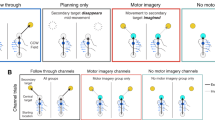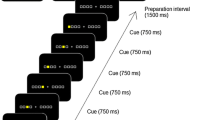Abstract
The aim of the present study is to gain more insight into the mechanisms underlying mental practice. The question of whether a totally novel movement may be learned by mental practice was investigated. Healthy young adults had to learn the abduction of the big toe (dominant right foot) without moving the other toes or the foot. The subjects were divided into two groups: subjects who were absolutely unable to abduct their big toe ("absolute zero" group) and subjects who were able to abduct their toe to some extent but showed clear room for improvement ("already doing it" group). Two separate experiments were executed. In the first experiment, 37 absolute-zero subjects had to practice, mentally or physically, the target movement. In the second experiment 40 already-doing-it subjects had to improve their toe-abduction skill. The results showed that absolute-zero subjects could not acquire the toe-abduction movement by means of mental practice. Only subjects who physically practiced the target movement improved significantly. Subjects who had some experience in the task (already-doing-it subjects) improved significantly after mental practice as well as after physical practice. The results seem to indicate that it is more plausible to explain the learning effects of mental practice in terms of a "top-down" mechanism based on the activation of a central representation of the movement than in terms of a peripheral "bottom-up" mechanism based on the activation of muscles.


Similar content being viewed by others
References
Abbruzzese G, Trompetto C, Schieppati M (1996) The excitability of the human motor cortex increases during execution and mental imagination of sequential but not repetitive finger movements. Exp Brain Res 111:465–472
Bakker FC, Boschker MSJ, Chung T (1996) Changes in muscular activity while imagining weight lifting using stimulus or response propositions. J Sport Exerc Psychol 18:313–324
Boschker MSJ (2001) Action-based imagery: on the nature of mentally imagined motor actions. Free University Doctoral thesis, Amsterdam
Crammond DJ (1997) Motor Imagery: never in your wildest dream. Trends Neurosci 20:54–57
Decety J (1996) The neurophysiological basis of motor imagery. Behav Brain Res 77:45–52
Decety J, Grèzes J (1999) Neural mechanisms subserving the perception of human actions. Trends Cogn Sci 3:172–178
Decety J, Jeannerod M, Germain M, Pastene J (1991) Vegetative response during imagined movement is proportional to imagined effort. Behav Brain Res 42:1–5
Decety J, Jeannerod M, Durozard D, Baverel G (1993) Central activation of autonomic effectors during mental simulation of motor actions in man. J Physiol (Lond) 461:549–563
Driskell JE, Copper C, Moran A (1994) Does mental practice enhance performance? J Sport Psychol 79:481–492
Elias LJ, Bryden MP, Bulman-Flemming MB (1998) Footedness is a better predictor than handedness of emotional lateralization. Neuropsychologia 36:37–43
Fansler CL, Poff CL, Shepard KF (1985) Effects of mental practice on the balance in elderly women. Phys Ther 65:1332–1338
Feltz DL, Landers DM (1983) The effects of mental practice on motor skill learning and performance: a meta-analysis. J Sport Psychol 5:25–57
Gerardin E, Sirigu A, Lehéricy et al. (2000) Partially overlapping neural networks for real and imagined hand movements. Cereb Cortex 10:1093–1104
Hale BD (1982) The effects of internal and external imagery on muscular and ocular concomitants. J Sport Exerc Psychol 4:379–387
Hall C, Bernoties L, Schmidt D (1995) Interference effects of mental imagery on a motor task. Br J Psychol 86:181–190
Hanakawa T, Immisch I, Toma K et al. (2003) Functional properties of brain areas associated with motor execution and imagery. J Neurophysiol 89:989–1002
Isaac AR, Marks DF, Russell DG (1986) An instrument for assessing imagery of movement: the Vividness of Movement Imagery Questionnaire. J Mental Imagery 10:23–30
Jackson PL, Lafleur MF, Malouin F, Richards C, Doyon J (2001) Potential role of mental practice using motor imagery in neurologic rehabilitation. Arch Phys Med Rehab 82:133–1141
Jacobson E (1932) Electrophysiology of mental activities. Am J Psychol 44:677–694.
Jeannerod M (1994) The representing brain: neural correlates of motor intention and imagery. Behav Brain Sci 17:187–245
Jeannerod M (1995) Mental imagery in the motor context. Neuropsychology 33:1419–1432
Jeannerod M, Decety J (1995) Mental motor imagery: a window into the representational stages of action. Curr OpinNeurobiol 5:727–732
Johnson SH (2000) Imaging the impossible: intact motor representations in hemiplegics. Neuroreport 11:729–732
Johnson SH, Spreh G, Saykin AJ (2002) Intact motor imagery in chronic upper limb hemiplegics: evidence for activity-independent action representations. J Cogn Neurosci 14:841–852
Jowdy DP, Harris DV (1990) Muscular responses during mental imagery as a function of motor skill level. J Sport Exerc Psychol 12:91–201
Livesay JR, Samras MR (1998) Covert neuromuscular activity of the dominant forearm during visualization of a motor task. Percept Mot Skills 86:371–374
Lotze M, Montoya P, Erb M et al. (1999) Activation of cortical and cerebellar motor areas during executed and imagined hand movements: an fMRI study. J Cogn Neurosci 11:491–501
Mackay DG (1981) The problem of rehearsal or mental practice. J Mot Behav 13:274–285
Magill RA (1998) Motor learning: concepts and applications. MacGraw-Hill, New York
Mulder Th, Hulstijn W (1985a) Sensory feedback and the learning of a novel motor task. J Mot Behav 17:110–128
Mulder Th, Hulstijn W (1985b) Delayed sensory feedback and the learning of a novel motor task. Psychol Res 47:203–209
Naito E, Kochiyama T, Kitada R et al. (2002) Internally simulated movement sensations during motor imagery activate cortical areas and the cerebellum. J Neurosci 22:3683–3691
Page SJ (2000) Imagery improves upper extremity motor function in chronic stroke patients: a pilot study. Occup Ther J Res 20:200–215
Page SJ, Levine P, Sisto A, Johnston MV (2001) Mental practice combined with physical practice for upper-limb motor deficit in subacute stroke. Phys Ther 81:1455–1462
Pascual-Leone A, Nguyet D, Cohen L et al. (1995) Modulation of muscle responses evoked by transcranial magnetic stimulation during the acquisition of new fine motor skills. J Neurophysiol 74:1037–1045
Porro CA, Francescato MP, Cettolo V et al. (1996) Primary motor and sensory cortex activation during motor performance and motor imagery: a functional magnetic resonance imaging study. J Neurosci 16:7688–7698
Richardson A (1969) Mental imagery. Springer, New York
Schmidt RA, Lee TD (1999) Motor control and learning: a behavioural emphasis. Human Kinetics, Champaign, IL
Shaw W (1940) The relation of muscular action potentials to imaginal weightlifting. Arch Psychol 35:5–50
Warner L, McNeill ME (1988) Mental imagery and its potential for physical therapy. Phys Ther 68:516–521
Wehner T, Vogt S, Stadler M (1984) Task-specific EMG characteristics during mental training. Psychol Res 46:389–401
Weiss T, Hansen E, Beyer L et al. (1994) Activation during mental practice in stroke patients. Int J Psychophysiol 17:91–100
Yue G, Cole KJ (1992) Strength increases from the motor program: comparison of training with maximal voluntary and imagined muscle contractions. J Neurophysiol 67:1115–1123
Author information
Authors and Affiliations
Corresponding author
Rights and permissions
About this article
Cite this article
Mulder, T., Zijlstra, S., Zijlstra, W. et al. The role of motor imagery in learning a totally novel movement. Exp Brain Res 154, 211–217 (2004). https://doi.org/10.1007/s00221-003-1647-6
Received:
Accepted:
Published:
Issue Date:
DOI: https://doi.org/10.1007/s00221-003-1647-6




